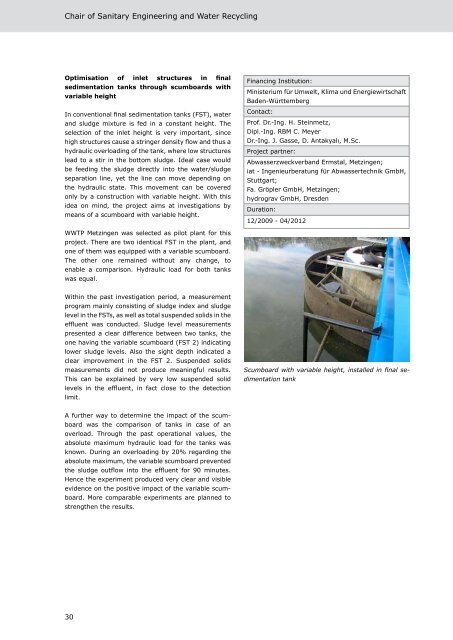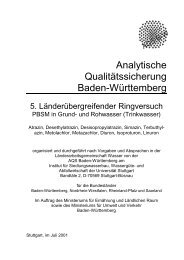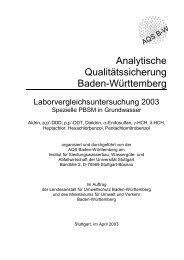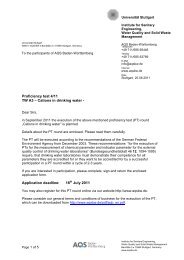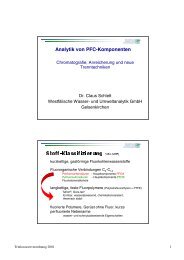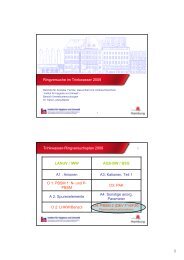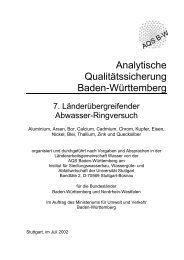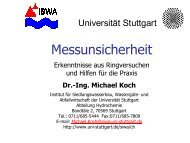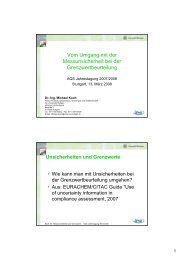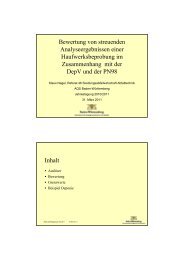Download - Institut für Siedlungswasserbau, Wassergüte- und ...
Download - Institut für Siedlungswasserbau, Wassergüte- und ...
Download - Institut für Siedlungswasserbau, Wassergüte- und ...
Create successful ePaper yourself
Turn your PDF publications into a flip-book with our unique Google optimized e-Paper software.
Chair of Sanitary Engineering and Water Recycling<br />
Optimisation of inlet structures in final<br />
sedimentation tanks through scumboards with<br />
variable height<br />
In conventional final sedimentation tanks (FST), water<br />
and sludge mixture is fed in a constant height. The<br />
selection of the inlet height is very important, since<br />
high structures cause a stringer density flow and thus a<br />
hydraulic overloading of the tank, where low structures<br />
lead to a stir in the bottom sludge. Ideal case would<br />
be feeding the sludge directly into the water/sludge<br />
separation line, yet the line can move depending on<br />
the hydraulic state. This movement can be covered<br />
only by a construction with variable height. With this<br />
idea on mind, the project aims at investigations by<br />
means of a scumboard with variable height.<br />
Financing <strong>Institut</strong>ion:<br />
Ministerium für Umwelt, Klima <strong>und</strong> Energiewirtschaft<br />
Baden-Württemberg<br />
Contact:<br />
Prof. Dr.-Ing. H. Steinmetz,<br />
Dipl.-Ing. RBM C. Meyer<br />
Dr.-Ing. J. Gasse, D. Antakyalı, M.Sc.<br />
Project partner:<br />
Abwasserzweckverband Ermstal, Metzingen;<br />
iat - Ingenieurberatung für Abwassertechnik GmbH,<br />
Stuttgart;<br />
Fa. Gröpler GmbH, Metzingen;<br />
hydrograv GmbH, Dresden<br />
Duration:<br />
12/2009 - 04/2012<br />
WWTP Metzingen was selected as pilot plant for this<br />
project. There are two identical FST in the plant, and<br />
one of them was equipped with a variable scumboard.<br />
The other one remained without any change, to<br />
enable a comparison. Hydraulic load for both tanks<br />
was equal.<br />
Within the past investigation period, a measurement<br />
program mainly consisting of sludge index and sludge<br />
level in the FSTs, as well as total suspended solids in the<br />
effluent was conducted. Sludge level measurements<br />
presented a clear difference between two tanks, the<br />
one having the variable scumboard (FST 2) indicating<br />
lower sludge levels. Also the sight depth indicated a<br />
clear improvement in the FST 2. Suspended solids<br />
measurements did not produce meaningful results.<br />
This can be explained by very low suspended solid<br />
levels in the effluent, in fact close to the detection<br />
limit.<br />
Scumboard with variable height, installed in final sedimentation<br />
tank<br />
A further way to determine the impact of the scumboard<br />
was the comparison of tanks in case of an<br />
overload. Through the past operational values, the<br />
absolute maximum hydraulic load for the tanks was<br />
known. During an overloading by 20% regarding the<br />
absolute maximum, the variable scumboard prevented<br />
the sludge outflow into the effluent for 90 minutes.<br />
Hence the experiment produced very clear and visible<br />
evidence on the positive impact of the variable scumboard.<br />
More comparable experiments are planned to<br />
strengthen the results.<br />
30


